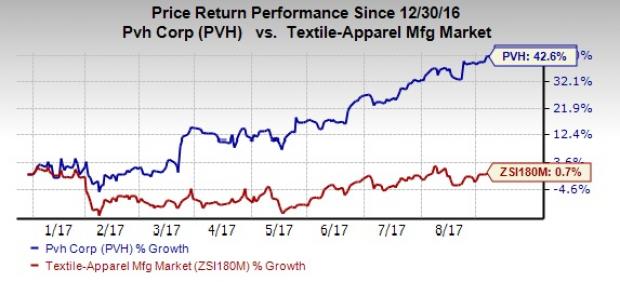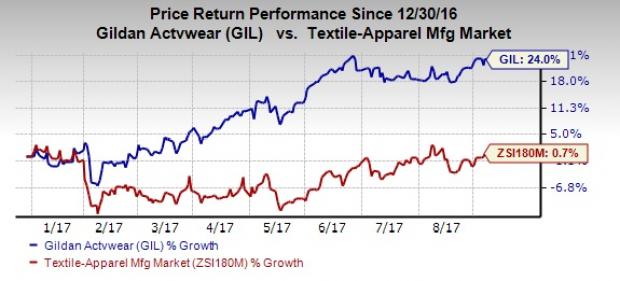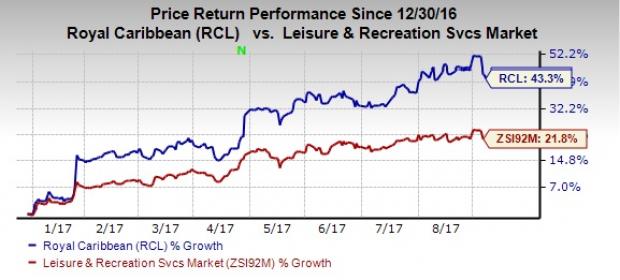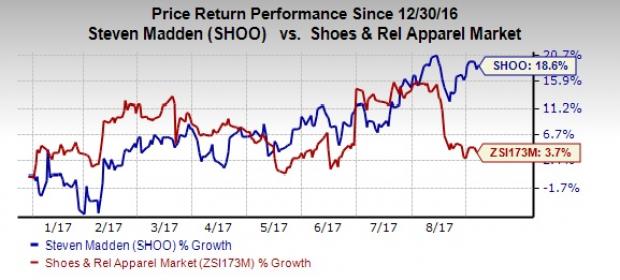Consumers are considered to be the core of almost all economic activity. Recent data on jobs, income, inflation and economic growth reveal that consumers are currently in a favorable position, raising chances of increased spending.
The labor department’s jobs data illustrates a tightened jobs scenario, with unemployment rate remaining range bound. Recent reports show that unemployment rate rose unexpectedly to 4.4% in August following a 4.3% growth in July.
Further, the commerce department stated that annual gross domestic product (GDP) rose 3% in second-quarter 2017, marking the best growth in three years. This growth was supported by robust consumption gains of 3.3%. Consumption accounts for nearly 70% of the economy.
Notably, consumer spending for July increased 0.3% after an upside of 0.2% in June. While this reflected a slight slowdown from the economists forecast of 0.4% growth, it still indicates that consumers are willing to spend primarily backed by the strong labor market.
Apart from this, other factors influencing the consumers’ willingness to spend are rise in incomes and lower inflation.
Incomes rose 0.4% in July, reflecting the highest since February. Further, personal consumption expenditure (PCE) price index excluding food and energy, which is Fed’s preferred inflation measure, increased only 0.1% remaining stable for three consecutive months. Further, it grew at an annual rate of 1.4%, which is below the Federal Reserve’s 2% target. The central bank’s preferred inflation gauge has matched or topped policy makers’ target in just two months since 2012.
The solid consumer spending, supported by a chic jobs scenario, indicates that the economy is well-poised for consistent growth in the second half of 2017. Further, the diminishing inflation rate lowers the Federal Reserve’s chances to raise borrowing rates for the third time this year, in the scheduled December meeting.
Moreover, these positives from the economic data were reflected in Consumer Confidence, which reached the second highest level in August since late 2000. The Conference Board’s Consumer Confidence Index surged to 122.9 last month from July’s revised reading of 120.
How the Consumer Discretionary Sector Stands to Gain From This Trend
Well, spending on discretionary items which form part of the Consumer Discretionary sector is largely dependent on consumers’ spending appetite. Given the favorable background discussed above, consumers are currently willing to spend on discretionary items like durable goods, apparel, entertainment and leisure, and automobiles.
The Consumer Discretionary sector growth trends since the start of 2017 have been very appeasing. Markedly, the sector recorded 12.6% growth year to date, comfortably outpacing the 10.2% upside of the S&P 500.

Further, it carries a Zacks Sector Rank of #5 (out of 16), placing it at the top 31% of the Zacks Classified sectors.
Hence, there lies an opportunity to invest in Consumer Discretionary stocks which are poised to make the best of the improving economic situation.
Picking the Right Stocks
Though investing in the Consumer Discretionary space makes perfect sense at this point. However, making the right choices is tedious.
The volatility in equity markets has always been a concern even for the smartest and wittiest investors. So, formulating a strategy is always ideal to skim the cream of the markets. One such strategy that has recently emerged is to invest in stocks that are currently winning and have further growth potential.
This entails picking the stocks that are trading near their 52-week highs. This tried and tested technique is based on the new investment mantra, “buy high and sell higher.”
Why Stocks Near 52-Week High are Good Bets
Investing in stocks near 52-week high runs parallel to the momentum strategy, which formulates that a trend once is established, it is likely to continue. The surge is driven by a broad set of factors including impressive sales, robust profitability and bullish earnings prospects. Major developments may also send stocks soaring.
Meanwhile, stocks that are trading near 52-week highs carry the risk of declining rapidly as the market might consider them overvalued. But the positives seem to outweigh drawbacks.
Notably, momentum investors strongly believe in “the trend is your friend”, which means stocks that are growing will continue to grow. They make short-term choices among stocks that are scaling up and sell them at the first sign of a downtrend. The basic idea is that once a trend is recognized, it is likely to continue and the chances of a reversal are minimal.
Thus, picking such stocks might help investors earn higher returns in the short term. However, this is only a speculative strategy and has its share of risks.
Consumer Stocks Worth Buying Now
As stated above, there is an amount of risk involved in picking the stocks at 52-week high. Hence, we suggest clubbing this parameter with other sure shot growth drivers like a VGM Score of A or B , Zacks Rank #1 (Strong Buy) or 2 (Buy), sound fundamentals, surging share price and a track record of better-than-expected results. That said, we hand-picked five Consumer Discretionary stocks that are positioned to benefit from the ongoing economic and sector trends.
First on the list is PVH Corporation (NYSE:PVH) , which specializes in designing and marketing branded dress shirts, neckwear, sportswear, jeanswear, intimate apparel, swim products, footwear, handbags and other related products. The company currently has a VGM Score of A and sports a Zacks Rank #1. You can see the complete list of today’s Zacks #1 Rank stocks here.
Earnings estimates have witnessed an uptrend in the last seven days with estimates for the current fiscal year trending up 0.3%. Also, the stock surpassed estimates by an average of 3.6% in the trailing four quarters. The long-term expected earnings growth rate for PVH is 12.6%. Moreover, the stock has gained a solid 42.6% year to date, outperforming the industry’s 0.7% increase. Closing at $128.69 on Sep 7, the stock is trading near its 52-week high mark of $130.75.

Another lucrative option is Los Angeles-based Guess? Inc. (NYSE:GES) . The company designs, markets, distributes and licenses casual apparel and accessories for men, women and children, per the American lifestyle and European fashion sensibilities. It has a VGM Score of A and carries a Zacks Rank #2. Moreover, the company has recorded an average positive earnings surprise of 20.6% in the preceding four quarters. Estimates for the current fiscal have moved up 27.5% to 51 cents per share in the last 30 days. Further, the company has a long-term expected earnings growth rate of 17.5%. The stock grew 33.6% year to date, outperforming the industry’s 0.8% upside. Moreover, the company closed trade at $16.16 on Sep 7, hovering near its 52-week high mark of $16.55.

Investors can also count on Gildan Activewear, Inc. (TO:GIL) , a manufacturer and seller of apparel products in the United States, Canada, Mexico, Europe, Asia Pacific, and Latin America. This Montreal, Canada -based company has delivered an average positive earnings surprise of 5.5% in the trailing four quarters. Estimates for the current fiscal have moved up by 1 cent to $1.69 per share in the last 60 days. The company currently has a VGM Score of B and long-term expected earnings growth rate of 13.5%. Moreover, this Zacks Rank #2 stock has gained 24% year to date, outperforming the industry’s 0.7% growth. The stock closed at $31.47 on Sep 7, near its 52-week high of $31.83.

Next comes Miami, FL-based Royal Caribbean Cruises Ltd. (NYSE:RCL) , a cruise company operating cruises under the Royal Caribbean International, Celebrity Cruises, and Azamara Club Cruises brand names. The company has a track record of delivering positive earnings surprises with an average beat of 3.5% in the trailing four quarters. Further, this Zacks Rank #2 stock has a long-term earnings growth rate of 20.8% and a VGM Score of A. It has witnessed positive estimate revisions for the current quarter, with estimates trending up 2 cents to $7.44 per share in the last 30 days. Additionally, the stock has witnessed a solid 43.3% growth year to date, outperforming the industry’s 21.8% upside. Closing at $117.54 on Sep 7, the stock is trading near its 52-week high mark of $125.

Last but not the least, investors may consider Steven Madden, Ltd. (NASDAQ:SHOO) that designs, sources, markets, and sells fashionable brands and private label footwear for women, men, and children globally. The company currently carries a Zacks Rank #2 and a VGM Score of B. Earnings estimates for the current fiscal have witnessed an uptrend in the last 30 days, moving up nearly 1 cent to $2.25 per share. Moreover, the company has delivered positive earnings surprises with an average beat of 7.1% in the trailing four quarters. The long-term expected earnings growth rate for Steven Madden is 12.3%. The stock has gained an 18.6% year to date, outperforming the industry’s 3.7% growth. The stock closed at $42.40 on Sep 7, near its 52-week high of $43.80.

More Stock News: This Is Bigger than the iPhone!
It could become the mother of all technological revolutions. Apple (NASDAQ:AAPL) sold a mere 1 billion iPhones in 10 years but a new breakthrough is expected to generate more than 27 billion devices in just 3 years, creating a $1.7 trillion market.
Zacks has just released a Special Report that spotlights this fast-emerging phenomenon and 6 tickers for taking advantage of it. If you don't buy now, you may kick yourself in 2020.
Click here for the 6 trades >>
Royal Caribbean Cruises Ltd. (RCL): Free Stock Analysis Report
Steven Madden, Ltd. (SHOO): Free Stock Analysis Report
Guess?, Inc. (GES): Free Stock Analysis Report
PVH Corp. (PVH): Free Stock Analysis Report
Gildan Activewear, Inc. (GIL): Free Stock Analysis Report
Original post
Zacks Investment Research
